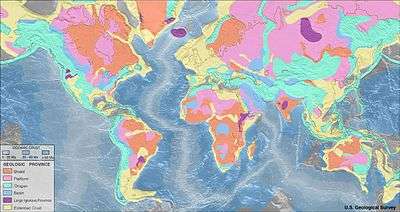Geologic province

}
A geologic or geomorphic province is a spatial entity with common geologic or geomorphic attributes.[1] A province may include a single dominant structural element such as a basin or a fold belt, or a number of contiguous related elements. Adjoining provinces may be similar in structure but be considered separate due to differing histories.
Geologic provinces by origin
| Province | Definition | Subcategories | Examples |
|---|---|---|---|
| Shield | Exposed Precambrian crystalline igneous and metamorphic rocks that form tectonically stable areas | ||
| Platform | Horizontal or gently-lying sedimentary strata covering a basement of igneous or metamorphic rocks | ||
| Orogen | Linear or arc-shaped formation where continental crust has been folded, deformed and uplifted to form mountain ranges | ||
| Basin | Low-lying formation of rock strata formed by tectonic warping of previously horizontal strata | ||
| Large igneous province | Accumulation of igneous rocks, including liquid rock (intrusive) or volcanic rock formations (extrusive) | ||
| Extended crust | Continental crust thinned due to extensional strain |
Geologic provinces by resources

US coal regions and provinces.
Some studies classify provinces based upon mineral resources, such as mineral deposits. There are a particularly large number of provinces identified worldwide for petroleum and other mineral fuels, such as the Niger Delta petroleum province.
See also
References
- ↑ "Geologic Province and Thermo-Tectonic Age Maps". Earthquake Hazards Program. United States Geological Survey. Retrieved 6 June 2014.
- "Geologic Provinces of the United States: Records of an Active Earth". United States Geological Survey. Retrieved 6 June 2014.
External links
This article is issued from Wikipedia - version of the 6/28/2016. The text is available under the Creative Commons Attribution/Share Alike but additional terms may apply for the media files.